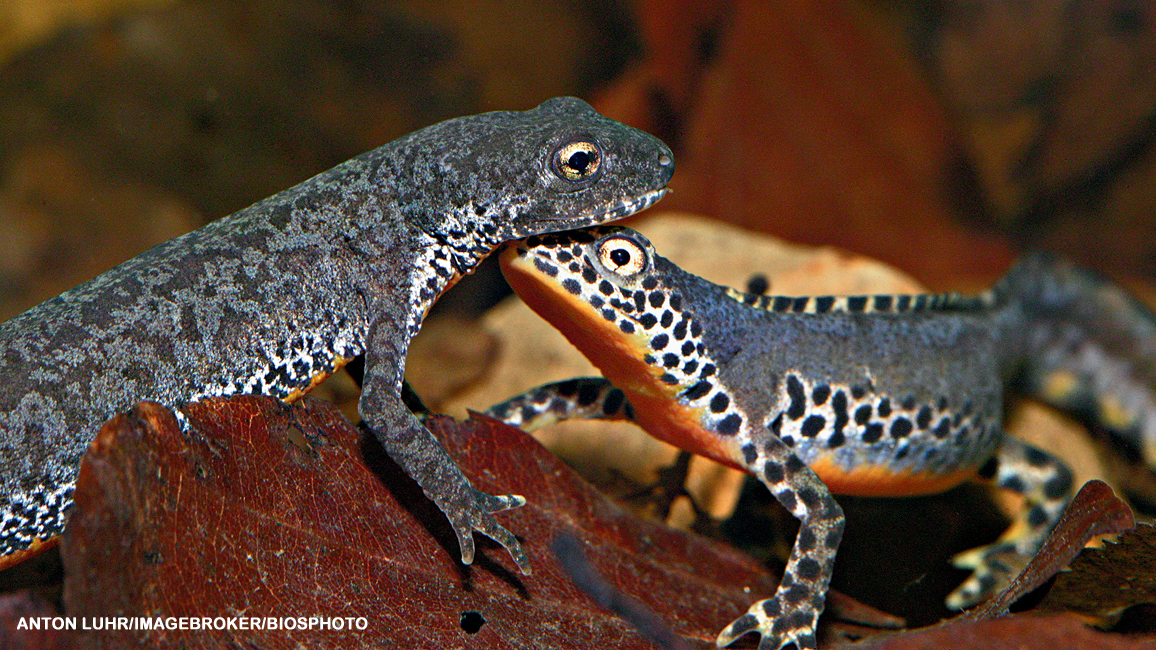
The Truth About Newts
By Ellen LambethHey, what’s newt? Stick around, and you’ll find out!

There’s a whole world of newts out there, and you’ll get to meet some of them on the next few pages. You might think the ones right here are dressed up a little early for Halloween. But those colors are just part of their natural, everyday costumes.
So, what exactly are newts? If you think they look like salamanders, you’re right. That’s because newts are a special family of salamanders. And that makes them—along with frogs and toads—amphibians. (You probably already know that amphibians live part of their lives in water, and part on land.)
If you compare newts with other salamanders, you may see a difference in their bodies. Most salamanders show creases between their ribs, while newts don’t. A newt’s skin is different, too. For one thing, it isn’t so slimy—and it usually looks rough instead of smooth. For another, it’s poisonous. That’s useful because it means not as many predators will want to make a meal of a newt.
These three colorful newts live in other parts of the world. Turn the page to meet a couple of newts you might see in the United States.

EASTERN NEWT
If you live in the eastern half of the United States, you may already have met an eastern newt like the ones on this page. That’s especially true if you visit a woodland after a rain. But was the newt reddish-orange or olive green?
The orange one is still young and is called a red eft. It lives on land for up to three years. When it’s fully grown, it’s green and lives mostly in water. Either way, this newt has a row of black-rimmed red spots along each of its sides. The color and pattern may be a little different, though, depending on where the newt lives.
WESTERN NEWT
If you’re near the West Coast, you might find a California newt, a Sierra newt, a red-bellied newt, or a rough-skinned newt. These newts look dark and dullish on top. But peek underneath, and
you’ll see a flash of bright yellow, orange, or red. If you were a hungry bird or shrew and went in for the attack, you’d get a big surprise. The newt would curl itself up into a stiff U-shape, showing off its bright underside. That flashes a warning that its poisonous skin can be bad news. If all goes well, the predator will get the message and go away. And the newt will get back to business, hunting down its own meal of a worm, spider, or other creepy-crawly.

A FAMILY AFFAIR
As winter pushes into spring, newts get ready to make new newts. And different kinds of newts have different ways of getting the job done. Some newts live most of their adult lives underwater. Others live mostly on land and return to the water to breed. Some of those might even travel for miles overland to reach the perfect pond or quiet stream for breeding. Whatever the species, underwater is where the magic happens.
Some male newts develop flashy colors and wide, flattened tails just for the season. They may “dance” to get the attention of a female. Or they may fan their tails back and forth Some males produce a special scent that attracts females. They use their tails to swish the scent toward a female’s nose. A male might clasp and cling to a female in a hug called amplexus.
After their courtship, the female newt lays her jelly-covered eggs, one at a time, and sticks them to underwater plants.
As with other salamanders, tadpole-like larvae (LAR-vee) hatch from the eggs and live their early lives underwater. At first, they use gills to take in oxygen from the water. Then they begin to develop legs and lungs. After that, they may leave the water and live their young lives on land. Finally, they return to the water as breeding adults—ready to start all over again!
















